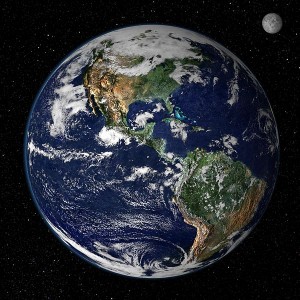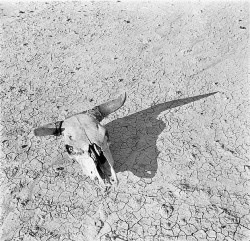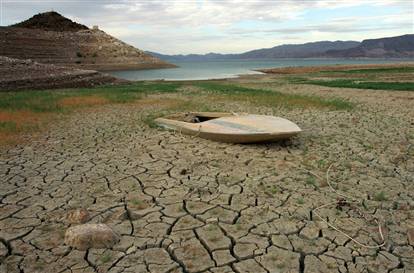 When is the economic collapse going to happen? Just open up your eyes and take a look around the globe. The next wave of the economic collapse may not have reached Wall Street yet, but it is already deeply affecting billions of lives all over the planet. Much of Europe has already descended into a deep economic depression, very disturbing economic data is coming out of the second and third largest economies on the globe (China and Japan), and in most of the world economic inequality is growing even though 80 percent of the global population already lives on less than $10 a day. Just because the Dow has been setting brand new all-time records lately does not mean that everything is okay. Remember, a bubble is always the biggest right before it bursts. The next major wave of the economic collapse is already sweeping across Europe and Asia and it is going to devastate the United States as well. I hope that you are ready.
When is the economic collapse going to happen? Just open up your eyes and take a look around the globe. The next wave of the economic collapse may not have reached Wall Street yet, but it is already deeply affecting billions of lives all over the planet. Much of Europe has already descended into a deep economic depression, very disturbing economic data is coming out of the second and third largest economies on the globe (China and Japan), and in most of the world economic inequality is growing even though 80 percent of the global population already lives on less than $10 a day. Just because the Dow has been setting brand new all-time records lately does not mean that everything is okay. Remember, a bubble is always the biggest right before it bursts. The next major wave of the economic collapse is already sweeping across Europe and Asia and it is going to devastate the United States as well. I hope that you are ready.
The following are 10 scenes from the economic collapse that is sweeping across the planet…
#1 27 Percent Unemployment/60 Percent Youth Unemployment In Greece
The economic depression in Europe just continues to get worse with each passing month. According to the Daily Mail, the unemployment rate in Greece has nearly tripled since 2009…
Greek youth unemployment rose above 60 per cent for the first time in February, reflecting the pain caused by the country’s crippling recession after years of austerity under its international bailout.
Greece’s jobless rate has almost tripled since the country’s debt crisis emerged in 2009 and was more than twice the euro zone’s average unemployment reading of 12.1 percent in March.
While the overall unemployment rate rose to 27 per cent, according to statistics service data released on Thursday, joblessness among those aged between 15 and 24 jumped to 64.2 percent in February from 59.3 percent in January.
#2 Detroit, Michigan Is Insolvent And Is Rapidly Running Out Of Cash
I love to write about Detroit because it is a perfect example of where the rest of the country is headed. They have just gotten there first. At this point, Detroit is essentially bankrupt, and the new emergency financial manager is saying that Detroit may totally run out of cash next month…
Detroit may run out of cash next month and must cut long-term debt and retiree obligations, according to emergency financial manager Kevyn Orr’s preliminary plan to save Michigan’s largest city from bankruptcy.
Orr’s report says the cost of $9.4 billion in bond, pension and other long-term liabilities is sapping the ability to provide public safety and transportation. He listed cutting debt principal, retiree benefits and jobs among his options.
“No one should underestimate the severity of the financial crisis,” Orr said yesterday in a statement. He called his report “a sobering wake-up call about the dire financial straits the city of Detroit faces.”
#3 Economic Despair In France
France is going down the same path that Greece, Spain, Portugal and Italy have gone. The following is an excerpt from a recent article in the Economist…
HELDER PEREIRA is a young man with no work and few prospects: a 21-year-old who failed to graduate from high school and lost his job on a building site four months ago. With his savings about to run out, he has come to his local employment centre in the Paris suburb of Sevran to sign on for benefits and to get help finding something to do. He’ll get the cash. Work is another matter. Youth unemployment in Sevran is over 40%.
#4 7,000 Abandoned Buildings In Dayton, Ohio
All over the upper Midwest, there are formerly great cities that are dealing with thousands of abandoned buildings. Dayton, Ohio is one example…
Like many urban cities in recent years, Dayton still finds itself knee-deep in abandoned, dilapidated properties as the result of the foreclosure crisis and economic downturn five years ago.
Boarded up buildings that appear to be on their last legs litter the city as it attempts to recover.
Kevin Powell, the city’s acting manager of housing inspection, says officials plan to use $5.2 million — half from the state’s Moving Ohio Forward program and a matching grant from the city’s general fund — to raze 475 abandoned properties by the end of September.
That will scratch the surface of an estimated 7,000 abandoned property problem that is growing.
#5 Overwhelmed By Squatters In Spain
In Spain, unemployment is rampant and people have become incredibly desperate. In fact, in some Spanish cities you can now find entire apartment buildings that are being overwhelmed by squatters…
A 285-unit apartment complex in Parla, less than half an hour’s drive from Madrid, should be an ideal target for investors seeking cheap property in Spain. Unfortunately, two thirds of the building generates zero revenue because it’s overrun by squatters.
“This is happening all over the country,” said Jose Maria Fraile, the town’s mayor, who estimates only 100 apartments in the block built for the council have rental contracts, and not all of those tenants are paying either. “People lost their jobs, they can’t pay mortgages or rent so they lost their homes and this has produced a tide of squatters.”
#6 The Collapse Of Chinese Power Consumption
Energy consumption tends to closely mirror economic activity. That is why the recent collapse of Chinese power consumption is so alarming. The following is from Zero Hedge…
According to CLSA’s Chris Wood using NEA data, China’s monthly power consumption (the most accurate proxy for underlying economic strength according to the current premier) growth slowed from 5.5% YoY in Jan-Feb 2013 to 1.9% YoY in March, the slowest growth rate since May 2009 (as discussed in-depth here).
#7 Horrible Economic Data Coming Out Of The Second Largest Economy On The Planet
The economic data that has been coming out of the second largest economy on the globe has been quite alarming recently…
For starters, China’s recent economic data, as massaged as it is to the upside, is downright awful. China’s PMI numbers were the worst in two years. Staffing levels in the Chinese service sector decreased for the first time since January 2009 (remember that year).
China’s LEI also shows no sign of recovery. If anything, it indicates China is heading towards an economic slowdown on par with that of 2008. And if you account for the rampant debt fueling China’s economy you could easily argue that China is posting 0% GDP growth today.
#8 One Out Of Every Five U.S. Households On Food Stamps
Back in the 1970s, about one out of every 50 Americans was on food stamps. Today, even though we are supposedly in the midst of an “economic recovery”, food stamp enrollment continues to soar to new highs. The following is from CNS News…
The most recent Supplemental Assistance Nutrition Program (SNAP) statistics of the number of households receiving food stamps shows that 23,087,886 households participated in January 2013 – an increase of 889,154 families from January 2012 when the number of households totaled 22,188,732.
The most recent statistics from the United States Census Bureau– from December 2012– puts the number of households in the United States at 115,310,000. If you divide 115,310,000 by 23,087,866, that equals one out of every five households now receiving food stamps.
#9 Child Hunger In America
Those that work for the big banks on Wall Street may have no problems feeding their children, but overall there is a rapidly growing child hunger crisis in America today. Just check out the following statistics from one of my previous articles…
*For the first time ever, more than a million public school students in the United States are homeless. That number has risen by 57 percent since the 2006-2007 school year.
*In Miami, 45 percent of all children are living in poverty.
*In Cleveland, more than 50 percent of all children are living in poverty.
*According to a recently released report, 60 percent of all children in the city of Detroit are living in poverty.
#10 The Tremendous Suffering Of Hundreds Of Millions Of Desperately Poor People That We Never Hear About
There are billions of people around the globe that are deeply suffering but that do not have a voice. We usually never hear about the desperate poverty that these people are living in, but that doesn’t mean that they don’t exist. The following statistics that Stephen Lendman recently compiled should shock and alarm you…
At least 80% live on less than $10 a day. Over three billion people live on less than $2.50 a day. More than 80% live in countries where income disparity is increasing.
The poorest 40% of world population has 5% of global income. The bottom fifth has $1.5%. The top 20% has 75%.
According to UNICEF, 22,000 impoverished children die daily. They “die quietly in some of the poorest villages on earth, far removed from the scrutiny and the conscience of the world. Being meek and weak in life makes these dying multitudes even more invisible in death.”
An estimated 28% of children in developing countries are underweight, malnourished and/or stunted.
How can so many people be living like that in a world with such wealth?
Sadly, things are going to get much worse. The economic and financial systems of the world are rapidly breaking down, and in a few years these are going to look like “the good old days”.
And a growing number of people are starting to realize the direction that things are headed. For example, according to a survey that has just been released, 48 percent of all Americans believe that the best days of America are now behind us.
So what do you think?
Are our best days behind us, or are they still ahead of us?
Please feel free to post a comment with your thoughts below…

